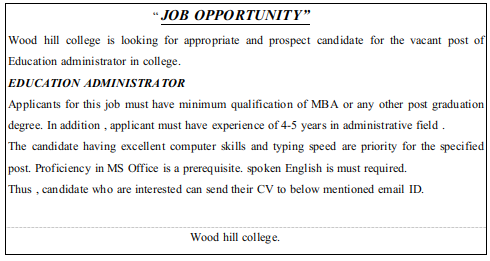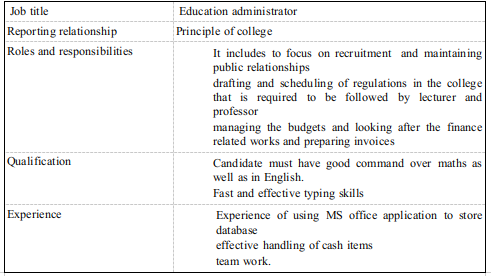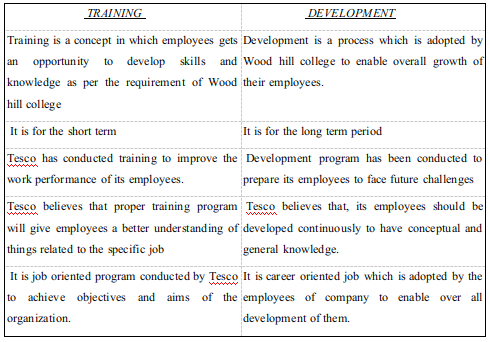Introduction
The term human resource management is being utilized for the purpose of describing formal systems that are being developed by management of firm. The responsibilities of HR manager is staffing, employee compensation and benefits and designing work. The main purpose of HRM is to maximize the productivity of an organization.
In this study human resource management has been discussed of various companies and organization. This report will also discuss different features and functions of HR manager. Different approaches of selection and recruitment are also being discussed .employment relations in an organisation has been discussed further in the report.
TASK 1
a) The Purpose of Workforce Planning and the Role of the HR Manager
Workforce planning means a systematic, fully integrated process in organization that involves planning further to avoid any talent surpluses and shortages (Armstrong and Taylor, 2014). It is basically , a concept in which it wants that company should have a proper staff , if it forecasts its talent needs along with actual supply of talent. In Wood hill college , as there is a requirement of staff, HR has been appointed to select and recruit people. HR is a who train, and develop staff and ensure discipline in them (Wright and McMahan, 2011). HR manager ensures following points while recruiting in Wood hill college:
- HR analyze total number of employees needed in an organization at a particular point of time.
- The planning of workforce helps HR manger to assign the jobs according to abilities of candidate.
- HR manager plays an important role in identifying the requirements of workforce planning.
- HR manager considers the present and future impact of internal and external environment.
b) The Strengths and Weaknesses of Different Approaches to Recruitment
There are different approaches to the recruitment and selection process in an organization. Recruitment is the fundamental process in an organization, which involves overall human resource management and planning process (Bloom and Van Reenen, 2011). It is the process related to attempt of locating and to encourage potential applicants to apply for a job. while, selection is the process which involves choosing a appropriate candidate from applicants for a job(Purce, 2014.). There are two kinds of recruitment in Wood hill college :
1. Internal Recruitment– Internal recruitment is the process in which employment opportunity is filled from inside business. It includes promotion and transfer from among the present employees .
- Strength of this approach is person get recruited by present employees, which are experienced and have better knowledge. Wood hill college will have the advantage of cost efficiency by this approach. Along with the candidates are already familiar with current environment.
- Weakness- recruiting a person internally , may cause the loss of talent as it could be possible that a better person can be allotted through external approach.
2. External Recruitment- it is the type of recruitment which can be done by giving an advertisement. In wood hill college, external recruitment is done by advertising a vacant posts through advertisement.
- Strength of this approach is that the position is filled by capable person when it isnot possible to filled by the current employee.
- Weakness- it can take longer and more cost.
c) How the Functions of the HRM can Provide Talent and Skills Appropriate to Fulfill the Business Objectives
Profitable corporations point out their success through proper management of human resources. HR by motivating employees to perform efficiently , it enables the company to achieve goals of company (Meredith Belbin, 2011). In wood hill college , the function of HRM is very important as discussed below:
- Recruitment- it is the basic function of HR manager of Wood hill college,to select and hire potential candidates.
- Training– after selection, HR manager has to provide on the job training to its employees.
- Motivation- HRM is responsible to motivate the employees by organizing various activities.
Assignment Prime is an online assignment writing service provider which caters the academic need of students.
Get Best Pricing Quotes Free Samples Email : help@assignmentprime.com Order Nowd) Evaluate the Strengths and Weaknesses of the Different Approaches to Recruitment and Selection
It is very important to evaluate strength and weaknesses of different approaches in recruitment (Lengnick-Hall, Beck and Lengnick-Hall, 2011). Strength and weakness are as follows:
1. Internal Recruitment
Strength:
- It is time saving task done by managers of Wood hill college .
- It is not expensive as HR manager need to to advertise the post through newspapers, televisions etc.
Weakness:
- The managers are not able to appoint the capable candidates , who are not iin the organization.
- The outside candidates are not aware of the vacant post.
2. External Recruitment
Strenght:
- HR of Wood hill college appoints the potential employees , who are fulfilling the job requirements.
- It is easy for Wood hill college to provide training regarding their task.
Weakness:
- It is a time consuming process.
- It is a long process, as selection is done through advertisements etc.
e) Critically evaluate the strengths and weaknesses of different approaches to recruitment and selection
As discussed above here, mainly,there are 2 approaches that are used for the recruitment process to select a candidate. In the above-mentioned approaches different strategies are implemented for recruitment. These 2 approaches , have both positive and negative impact on the business environment and objectives of Wood hill college (Jiang, Lepak, Hu and Baer, 2012). For this, an example has also been provided:
Internal Recruitment- when any job is vacated in organization, then no advertisement is required to be published. It consists of advantage for relatives, college and friends.
External Recruitment- when there is a vacancy in organization, it will advertise advertisement in newspapers, pamphlets and through brochure , about the specifications of the post..
TASK 2
a) Write a Job Advertisement for the Role

b) Identify Suitable Platforms to Place the Advertisement
In order to have the above designed job advertisement of Education administration it has been assessed that HR manger of wood hill college must have focus on suitable and effective platform for placing the advertisement, which includes-
Print Media Platform- It is the suitable platform for placing an advertisement of Education minister of Wood hill college as it includes all the job specifications which HR is looking for, in a candidate. It includes advertisement through newspapers, magazines, brochure etc.
Online Platform- it is another platform to place the advertisement of education administrator is using online platform. in this company can put their advertisement on the leading job website that reaches the wide mass of people that are registered or enrol on websites (Jackson, S., Schuler, R. and Werner, S., 2011). Along with this, it has been assessed that wood hill college may also create its own official website from which the college can easily impart the information regarding vacant post in college. the interested candidate can also submit their CV on website of the college.
c) Prepare a Job Specification and Person Specification for the Role
Job specification of Education Administrator

Person Specification of Education Administrator

d) Provide a Rationale for the Application of Specific HRM Practices
HR mangers are the persons who plans to mange human resources of company effectively. Human resource management aims at establishing a more open and flexible caring management style so as it will help staff to get motivated , developed and managed(Lengnick-Hall, Beck and Lengnick-Hall, 2011). In Wood hill college rationale practices to be performed by HR manager are:
1. To clarify department's strategic direction by way of mission and vision.
2. To ensure strategic linkage and conducting and integrating HR programs through HRM plans.
3. To manage people more effectively,
4. To establish a performance management system.
5. To conduct a training and development sessions.
6. To enhance the service quality of the staff and to motivate them to achieve the goals and objectives of organization.
TASK 3
a) Explain the Difference Between Training and Development
Training is the process to develop employee’s skills and competency. Development is a concept in which people are being prepared for additional job roles for long term (Jackson, Schuler and Werner, 2011). The company namely Tesco is a public company and it is engaged in a business of retail supermarket has conducted training and development induction for its employees.. The difference between training and development are:

b) Explain How have Changes in Customer Expectations Affected Tesco and its Need to Train Staff
Tesco is one of the leading super markets across the world. It is having more than 2000 stores in UK, and is the 3rd largest retailer in world. It is engaged in providing good retail services and meeting needs of their customers. It employed more than 275,000 people in UK. Customer expectations plays important role in developing an organization . This is so because, if an organization fulfills all the expectations then, it will develop good brand image. Customers want honest and fair deals from the company along with good quality products and services in healthy but comparitively cheaper products (Jackson, Schuler and Werner, 2011.). Customers of Tesco expect to have good services and response from company. They want a healthy and peaceful environment. Staff of Tesco should be trained to have healthy and fair interaction with customers. Staff of Tesco wants a helpful manager. Through training, employees will have better sense of responsibility.
c) List the Methods of Training Carried out by Tesco
Training methods are the ways in which the organization can conduct its training program (Huselid and Becker, 2010). Tesco , a public company, have conducted a good training session with effective strategy that delivers pleasing growth . There are two methods of training which has been adopted by Tesco:
1. On the job training- Tesco follows observation, coaching trainee, mentoring trainee and job rotation method for training. The company has adopted on the job training because it want its employees to become skilled by a trained person.
2. Off the job training- it is the method in which Tesco offers specific new talents which involvess :
- team building
- communication and establishment
- arrangement
d) Describe How Training Needs are Identified
Training needs involves assessment of performance of employees that will develop skills and capabilities.. In order to achieve business targets and aims proper training should be conducted so as to enable the employees of company to face challenges and tasks. A successful training needs analysis is conducted to identify those persons who require training and to provide training facilities to them.. It is also known as the pro active offer (Hendry, 2012.). Tesco time to time conducts training program to train and develop its employees because:
- In the event of change in technology, so as to aware and to provide them about the innovation and knowledge about technology.
- In the event of new task assignment of work.
- Any updates in process and procedure of the production of goods.
- In order to analyze the needs of business and business environment
- Analysis in order to deal with a potential buyer and participants.
e) Evaluate the Benefits for Tesco and the Employees in Providing a Structured Training Program
Structured training program means techniques and methodologies which are employed to develop professional skills and enhance proficiency of employees for performing better in the company (Harzing and Pinnington, 2010.). It focuses on achieving business objectives in such a way that it could attain growth and maximize profits of the company. Tesco, while operating its business conducts training sessions for employees to make them assets of the company.
The benefits of a structured training program are as follows:
- It is an effective program to increase business by providing quality services to the respective consumers.
- To train staff of Tesco, to perform in all business activities in a professional manner.
- It increases the efficiency of employees of company
- It increases return of investment and return on profits of the company.
- Company can also achieve SMART objectives by holding a good structured training session.
f) Indicate the Extent to Which you Think the Training has Achieved a Return on Investment
Training is efficient tool for overall development of the company. However, it is also very beneficial for growth of business by providing good customer services in a professional manner. It also increases return on investment of Tesco to a great extent. Employees of Tesco are trained enough to perform well in achieving objectives, through which it can achive success and build goodwill in the minds of costumers.. The total profit of company is about 3 billion pounds(Guest, 2011). The total number of stores present in UK are around 2300.. As the company's sales will increase, its profits will also get hiked . It happened due to good training structure program organised by company. This shows that the company has achieved a good return of investment.
g) Suggest the Types of Approaches to Flexibility that can be Adopted by Tesco to Aid its Expansion of the Business
The term flexibility means how an organization is working in a current market position to achieve its goals and targets on time. Flexibility is a concept or nature , through which business organisation changes according to market conditions (Fee, 2014). It is important for the management to frame policies according to prevailing market conditions. It will help Tesco, to improvise the working environment so to enhancing and increasing their efficiency. There are 2 types of flexibility approaches of Tesco:
1.Structural Approach- It means Tesco can alter strategies and policies according to the prevailing market trend. It will be beneficial for company to make alterations in its policies to achieve desired goals.
2. Numerical Approach- in this, Tesco ensures to save financial resources by selecting number of employees which need to be recruited and selected.
TASK 4
a) Importance for ITV to Maintain Good Employee Relationships
ITV has made development of various HRM for their employees and employer. It is the responsibility of the employer to maintain good relationships with its employee. ITV is of opinion that its working environment should be healthy and peaceful (Daley, 2012.). Employees of ITV should share healthy relation with each other because:
- several issues are there on which individual employee cannot take decisions.
- If the work is shared among all employees , it becomes easy.
- ITV becomes a happy place to work if its employees work together as a family.
- In ITV , if there will be healthy and working environment, its employees will feel motivated, can trust other employees too.
b) Key Elements in the Employee Legislation and Manner it Affects Decision-Making of ITV
ITV has adopted various strategies that has any advantages for employees, business and employers. with suitable means as well as by regular communication , no misunderstanding will take place in the company (CHUANG and Liao, 2010.). In addition, if any issue happens then it should be effectively communicated through out the organization , so as to avoid any ambiguity. Further such would assist the productivity of the firm to a great extent. it brings positive energy in business environment of company. It affects decision making power of company.
c) Key Aspects of Employee Relations Management
The success of any business organization depends to a great extent on the relationship between employees and management (Bratton and Gold, 2012.). Employee loyalty and commitment plays an important role in the growth. There should be clear management of employees in company so that it would be easy fir HR manager to mange human resources. ITV believes that their employees should work in positive as well as sound association. In addition, significance of employee relations for ITVis that the management of company ensures protection of personnel against any form of malpractices at working place. Therefore in accordance with the employment laws obligated by regulatory department of HR with ITV is required to make decisions , that favor the personnel who are performing in the business.
d) Critical Evaluation of Employee Relations and Application of HRM Practices in ITV
Employee relations means the relationship between the employees of an organization. It includes relationships between co worker, employee and his superior , between two members in management etc. these are very important part of the management (Boxall and Purcell, 2011). In ITV ,the HR manager always ensures that there should be good relationships between its employees . The importance of employee relations are-
if the relationship between employees are not good then, it will affect the decision making power of company, as their opinions will go in different streams which will lead to conflict. In addition, decisions cannot be formed due to conflict , it will result in dissatisfaction in the employees. This can be critically assessed by means of complying with the effective practices of HRMin ITV so that issues and conflicts between them can be clearly addressed.
Conclusion
It has been concluded from the present report that human resource management is regarded as a crucial part in an organization. it has great impact on the sustainability as well as consistency in organization. If wrong selection has been made by HR manager , it can result into negative outcomes. In this regard it is significant for the company to make evaluation of performance of employees and then make appraise of employees.
References
- Armstrong, M. and Taylor, S., 2014. Armstrong's handbook of human resource management practice. Kogan Page Publishers.
- Bloom, N. and Van Reenen, J., 2011. Human resource management and productivity. Handbook of labor economics. 4. pp.1697-1767.
- Boxall, P. and Purcell, J., 2011. Strategy and human resource management. Palgrave Macmillan.
- Bratton, J. and Gold, J., 2012. Human resource management: theory and practice. Palgrave Macmillan.
- CHUANG, C.H. and Liao, H.U.I., 2010. Strategic human resource management in service context: Taking care of business by taking care of employees and customers. Personnel Psychology.63(1). pp.153-196.
- Daley, D.M., 2012. Strategic human resource management. Public Personnel Management, pp.120-125.
- Fee, M.C., 2014. Human resources management.
- Guest, D.E., 2011. Human resource management and performance: still searching for some answers. Human resource management journal.21(1). pp.3-13.
- Harzing, A.W. and Pinnington, A. eds., 2010. International human resource management. Sage.
- Hendry, C., 2012. Human resource management. Routledge.
- Huselid, M.A. and Becker, B.E., 2010. Bridging micro and macro domains: Workforce differentiation and strategic human resource management. Journal of management.














